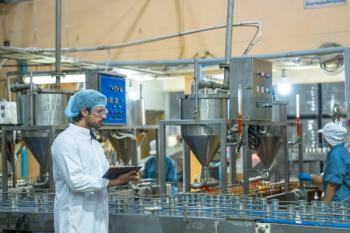
Inside the Laboratory: The Mercury Education and Research Consortium in Undergraduate Computational Chemistry
Key Takeaways
- MERCURY aims to conduct high-value research with undergraduates, increasing STEM graduates and fostering diversity across 45 institutions.
- Recent MERCURY Conference featured talks on quantum mechanics, machine learning, and carbon dioxide removal, resonating with students.
In this edition of “Inside the Laboratory,” George Shields, a professor of chemistry at Furman University and the founder and director of the Molecular Education and Research Consortium in Undergraduate Computational ChemistRY (MERCURY), discusses the goal of MERCURY and some of its most recent projects
"Inside the Laboratory" is a joint series with LCGC International and Spectroscopy, profiling analytical scientists and their research groups at universities all over the world. This series spotlights the current chromatographic and spectroscopic research their group is conducting, and the importance of their research in analytical chemistry and specific industries. In this edition of “Inside the Laboratory,” George Shields, a professor of chemistry at Furman University and the founder and director of the Molecular Education and Research Consortium in Undergraduate Computational ChemistRY (MERCURY), discusses the goal of MERCURY and some of its most recent projects (1,2). Part 1 of our discussion with Shields discusses the mission of MERCURY. Part 2 of our discussion will dive into Shields’s research into computational approaches to improve our understanding of molecular behavior in both biochemistry and atmospheric chemistry.
Can you discuss the main objective or mission statement of the MERCURY Consortium, as well as the recent projects the consortium is working on?
The main objective of the MERCURY consortium is to conduct high-value research projects with undergraduates. The faculty and students are diverse, and we strive to use highly mentored research projects to increase the number of college graduates who understand the scientific method and the value of research while fostering more students going on to professional and graduate degrees in STEM and medicine. We have 49 faculty working at 45 different institutions. Each faculty member works with a group of undergraduates at their institution. The projects are quite varied, from drug design to materials chemistry, to atmospheric chemistry, and to basic research understanding organic, physical, and biochemistry. Some groups also work on methods development to enhance the overall research field. Our faculty have published work in Science, Nature, Proceedings of the National Academy of Sciences (PNAS), Journal of the American Chemical Society (JACS), and other high-profile journals. What most of us would say is that our students that we send on to further studies are our most significant contribution, as workforce development is a key aspect of our work. Carol Parish, Maria Gomez, and I have all received the ACS Award for Research at an Undergraduate Institution. I founded the consortium in 2000 with six other faculty at liberal arts colleges in the northeast. Carol and Maria were assistant professors at Hobart & William Smith and Vassar College at that time. MERCURY has been a powerful accelerator of careers for all of the PUI faculty, and especially women and minorities who benefit tremendously from the mentoring aspects of the consortium. You can read three of the papers outlining this success in the literature (3–5).
What were some of the highlights of the recent MERCURY Conference that took place from July 21–25th? What talks stood out to you and why?
The talks by Susan Atlas at the University of New Mexico, Fang Liu at Emory University, and Jan Steckel at the National Energy Technology Laboratory were favored by students. Atlas explained how fundamental research in quantum mechanics and statistical thermodynamics has led to advances in materials design in the age of machine learning (ML) and artificial intelligence (AI) techniques, with particular application to high-temperature alloy design and the mechanochemistry of the kinesin molecular motor protein. Liu explained about the limits of ML models because of the lack of big data, and explained how her group has developed AutoSolvate, which has allowed her group to develop ML models that uncover design principles for catalysts. Steckel gave a nice overview for the students on how different undergraduate and early career pathways can change and lead to life as a scientist at a national laboratory. Her work running a group that is focused on removing carbon dioxide from the air was very well received by the audience.
Given the multi-agency support for your work (NIH, DOD, ACS PRF, NSF), how do you align your computational research to meet the goals of these diverse funding bodies, especially when spanning applications from cancer therapeutics to fundamental chemical processes?
I find grant writing to be hard because you must have a big idea that you can articulate in a comprehensive fashion. Whenever I move into a new field, I am naïve as I don’t have a great understanding of the literature, and learning and keeping up with the literature is a tremendous problem, particularly if you change areas of interest. I find that when I write a proposal that is not funded, a careful reading of the reviews allows me to revamp the proposal so that it is more likely to be funded in another round. I work on what I find to be interesting to me and try to adapt my projects to the funding mechanisms available. Most of the places I have worked have great grant offices, that help me find funding sources and make sure that I have crossed all the t’s and dotted all the i’s in a grant application.I have also had several great postdocs and research scientists who have helped me write grants, including Karl Kirschner and Berhane Temelso. Kirschner, who was my undergraduate student at Lake Forest College and worked with me for several years as a colleague at Hamilton College, and we have published 22 papers together. Temelso became a postdoc in my group when I started my administrative career at Armstrong Atlantic State University and moved with me to Bucknell and then to Furman as he transitioned into a research scientist role. Temelso, now a staff scientist at George Mason University, has been tremendously helpful in keeping my research program afloat during this time, and he and I have published 23 papers during the time period 2010–2021, including two in Science with Brooks Pate’s group at the University of Virginia, on water clusters. Running a research group at a PUI is difficult, and having smart people around who have Ph.D.s is an enormous help when one is exploring new directions and solving complex problems.
References
- Mercury Consortium, Conference 2025. Mercury Consortium. Available at:
https://www.mercuryconsortium.org/conference-2025/ (accessed 2025-08-05). - Furman University, George C. Shields. Furman.edu. Available at:
https://www.furman.edu/people/george-c-shields/ (accessed 2025-08-05). - Shields, G. Twenty years of exceptional success: The Molecular Education and Research Consortium in Undergraduate Computational Chemistry (MERCURY). Int. J. Quantum Chem. 2020, e26274. DOI: 10.1002/qua.26274
- Shields, G. The Molecular Education and Research Consortium in Undergraduate Computational Chemistry (MERCURY): Twenty Years of Exceptional Success Supporting Undergraduate Research and Inclusive Excellence. Scholar. Prac. Undergrad. Res. 2019, 3 (2), DOI: 10.18833/spur/3/2/1
- Shields, G. Research at Predominately Undergraduate Institutions Published Recently in The Journal of Physical Chemistry A, B, and C. J. Phys. Chem. C 2025, 129 (11), 5269–5272. DOI:
10.1021/acs.jpcc.5c00979
Newsletter
Get essential updates on the latest spectroscopy technologies, regulatory standards, and best practices—subscribe today to Spectroscopy.





